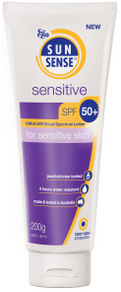Children

There are plenty of effective sun protection measures available for children. They should be carefully protected so that they are never at risk of getting sunburnt. Just one blistering episode of sunburn in childhood doubles their chance of developing melanoma later in life.
Babies 0 to 6 months
Babies under 6 months of age should be kept out of the sun as they have skin that is very sensitive to the damaging effects of sunlight. Also, their skin may be sensitive to many sunscreens. The skin is still forming in babies and the pigment cells that are responsible for making protective melanin are not fully active so they do not have any form of natural protection against sunlight. Every effort should be taken to ensure that they are carefully protected from the harmful effects of the sun by seeking the shade and using physical protection measures including clothing and pram shades. The addition of a low irritant sunscreen, for example, one with zinc or titanium (eg Ego Sunsense Sensitive) as the only active ingredient and without any fragrance, could be considered as supplementary protection only.
 Use window shields to keep direct sunlight from coming in through the windows of your car or get UV blocking window tinting.
Use window shields to keep direct sunlight from coming in through the windows of your car or get UV blocking window tinting.
Take your baby for walks before 10 AM or after 4 PM and use a stroller with a sun-protective cover.
Use lightweight clothing that covers the arms and legs.
Choose a wide-brimmed hat that protects the baby’s face, neck, and ears.
Infants 6 to 18 months
In addition to the protective measures for babies already mentioned, sunscreen use should be routinely incorporated. Generally it is safe to use low irritant sunscreens in infants older than 6 months, however, the chance of an allergic, or sensitivity type of reaction in this age group is higher than in older children.
Apply a broad-spectrum SPF 30+ sunscreen to areas that cannot be protected by clothing such as face and hands. Sunscreen should be applied 30 minutes before going outside and reapplied every two hours or after swimming.
When infants are learning to swim, get a full length swimming suit, or “rashie” that has a UPF of 50, apply plenty of sunscreen to the face, and avoid outdoor swimming during the hours of 11:00 am and 3:00 pm.
Toddlers and School Children
Once children become more mobile and spend more time outdoors, it is important that you ensure that their play area is shaded, and that they have protective clothing, including a hat and sunglasses, as well as plenty of broad spectrum sunscreen applied frequently to their face and hands.
Choose clothing and swimwear with a UPF of 50.
Educate your child about the importance of sun protection – remember the no hat no play policy which should be maintained at pre-school and school as well as at home and outdoor activities.
Motivate your child to apply a facial moisturiser with SPF 30+ to their face every day, even during winter, so that there is at least some protection from UV light of facial skin at all times.
By encouraging your child to follow adequate sun protection measures on a daily basis and whenever they are outside, you will give them the opportunity of learning to protect their skin at all times, not just when they are at the beach, and minimise their risk of developing skin cancers later in their lives.
What is Your Skin Cancer Risk?
Calculate your level of risk of developing a skin cancer from exposure to the sun.

